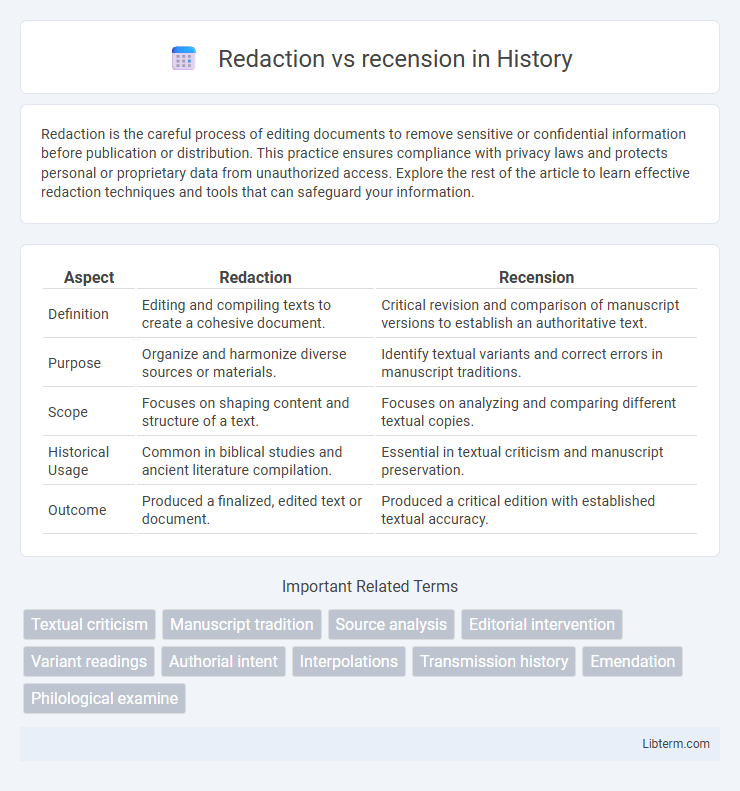Redaction is the careful process of editing documents to remove sensitive or confidential information before publication or distribution. This practice ensures compliance with privacy laws and protects personal or proprietary data from unauthorized access. Explore the rest of the article to learn effective redaction techniques and tools that can safeguard your information.
Table of Comparison
| Aspect | Redaction | Recension |
|---|---|---|
| Definition | Editing and compiling texts to create a cohesive document. | Critical revision and comparison of manuscript versions to establish an authoritative text. |
| Purpose | Organize and harmonize diverse sources or materials. | Identify textual variants and correct errors in manuscript traditions. |
| Scope | Focuses on shaping content and structure of a text. | Focuses on analyzing and comparing different textual copies. |
| Historical Usage | Common in biblical studies and ancient literature compilation. | Essential in textual criticism and manuscript preservation. |
| Outcome | Produced a finalized, edited text or document. | Produced a critical edition with established textual accuracy. |
Understanding Redaction: Definition and Purpose
Redaction involves the process of editing or preparing a text by selecting, organizing, and modifying content to achieve clarity, coherence, or ideological intent. Its primary purpose is to shape the narrative or message, often seen in biblical studies where editors compiled and adjusted various sources to create a unified text. Understanding redaction reveals how ancient manuscripts were curated to reflect theological perspectives or historical reinterpretations.
What is Recension? Key Concepts Explained
Recension refers to the scholarly process of comparing, analyzing, and editing different manuscript versions to establish an authoritative text, often used in biblical or classical studies. This critical method involves identifying variations, errors, and interpolations to reconstruct the original content or its earliest form. Key concepts include textual variants, critical apparatus, and editorial recension, which collectively facilitate accurate historical and literary analysis.
Historical Contexts: Redaction vs Recension
Redaction involves the editorial process of combining and modifying existing texts to create a unified narrative, often reflecting the theological or ideological perspectives of the redactor during specific historical periods. Recension refers to a systematic revision or critical edition of a manuscript tradition, aiming to restore or preserve the original text by comparing various copies and correcting errors introduced over time. Historical contexts reveal that redaction shaped biblical and ancient literary works to address contemporary audiences, while recension focused on preserving textual authenticity amidst numerous manuscript variants.
Core Differences Between Redaction and Recension
Redaction involves editing and organizing texts to create a coherent narrative, often incorporating theological or ideological perspectives, whereas recension refers to the comparison and critical revision of manuscript variants to establish an authoritative text. Redaction emphasizes the author's intent in shaping content, while recension prioritizes textual accuracy and fidelity by analyzing different manuscript traditions. These core differences highlight redaction as a creative editorial process and recension as a scholarly method of textual criticism.
Processes Involved in Redaction
Redaction involves the critical process of compiling, editing, and organizing textual sources to produce a coherent and authoritative document, often requiring selection, omission, and harmonization of material. This process includes evaluating variant manuscripts, integrating editorial notes, and refining narrative flow to preserve meaning while enhancing readability. Redaction contrasts with recension, which primarily focuses on comparing and establishing textual variants to restore an original or earliest version of the text.
Steps and Methods of Recension
Recension involves the systematic comparison and editing of various manuscript versions to establish a reliable text, employing methods such as collation, variant analysis, and textual criticism. Key steps include collecting all available copies, identifying discrepancies through thorough comparison, and reconstructing the original wording by evaluating linguistic, historical, and contextual clues. This meticulous process ensures the integrity of the text, distinguishing recension from redaction, which typically refers to authorial editing or revision.
Importance in Textual Criticism
Redaction and recension are critical concepts in textual criticism, where redaction refers to the editorial process of compiling and modifying source texts to create a coherent narrative, while recension involves the systematic comparison of manuscript variants to establish the most authentic version. Both processes are essential for reconstructing original texts, ensuring accurate transmission, and identifying scribal alterations or errors. Understanding the distinction between redaction and recension allows scholars to trace textual evolution and improve the reliability of critical editions.
Common Examples: Redaction and Recension in Practice
Redaction involves editing or revising texts to unify or clarify content, evident in biblical texts like the Pentateuch, where multiple sources are combined for coherence. Recension refers to different versions or manuscript traditions of the same text, seen in the variations between the Septuagint and Masoretic Texts of the Hebrew Bible. Common examples illustrate redaction shaping narrative flow, while recension reflects textual transmission and preservation through distinct textual families.
Impacts on Interpretation and Meaning
Redaction involves the editorial shaping of a text to harmonize or highlight theological themes, often influencing interpretation by introducing specific doctrinal emphases. Recension refers to the critical revision or comparison of manuscripts to establish the most authentic version, impacting meaning through the correction of errors or restoration of original wording. Both processes significantly affect the understanding of texts, with redaction shaping thematic intent and recension refining textual accuracy.
Redaction vs Recension: Summary Table
Redaction involves the process of editing and compiling original documents to create a coherent text, often seen in biblical studies where texts are harmonized or arranged thematically. Recension refers to the critical revision and comparison of manuscripts aimed at identifying and restoring the original version by analyzing variations and errors in textual transmission. The summary table contrasting redaction and recension highlights redaction as focused on content arrangement and interpretation, whereas recension emphasizes textual accuracy and authenticity through manuscript collation.
Redaction Infographic

 libterm.com
libterm.com